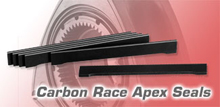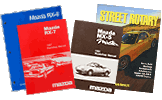Engine Seals

Racing Beat's carbon apex seals for high RPM and racing applications.
When increasing the power output of the rotary engine, there comes a point when bolting on an intake system and an exhaust system, combined with other external modifications, are simply not enough. Further horsepower gains require higher engine RPM operating levels which necessitate a number of internal engine component modifications and replacements.
The suggestions presented in this section are based on Racing Beat’s experience with the development of high performance rotary engine components, as well as tips gathered from other racers and the Mazda Factory.
We recommend that when rebuilding an engine that is stock in every respect, you should use only parts intended for the year engine you are rebuilding. However, if your goal is to build a high performance engine, Racing Beat offers a wide variety of component upgrades.
Apex Seals
From its introduction in the United States in 1970 through the 2007 production year, Mazda’s rotary engines have incorporated three different apex seal thicknesses:
- 1971-1973 -5mm aluminum-filled carbon seals
- 1974-85 - 3mm cast iron seals
- 1986-95 & RX-8 Renesis - 2mm cast iron seals.
While the thickness of the apex seals has decreased over the years, the overall reliability and compression sealing capabilities of these thinner seals have not been sacrificed. All 1986 and later engines - both turbo and non-turbo versions - utilize the thinnest (2mm) seals and produce the greatest horsepower.
Furthermore, we do not recommend attempting to retro-fit the 3mm apex seals (1974-85 type) into the later (1986-95) rotors, typically accomplished by machining the apex seal grooves - performance will not be improved and overall reliability will likely decrease.
There are three (3) common types of apex seals for 1974-95 engines: Cast iron (stock), aluminum-filled carbon, and ceramic. Your selection will depend on many factors, including: RPM range, normally aspirated or supercharged, acceptable wear rates, and cost. (Note: In this website, supercharged means either "turbocharged" or "mechanically supercharged".)
Cast Iron Apex Seals (stock) are best for many applications. As long as you never exceed 8,500 RPM (RX-8 - 9500 RPM) and don’t run the engine highly supercharged (not exceeding 12 psi of boost), the stock seals will "seal" better and last a long time. When building a high performance engine, run the latest model apex seal/rotor housing combination suitable for your series of engine.
Aluminum-Filled Carbon seals are well suited to high RPM, normally aspirated engines. They are moderate in price and very reliable. They do not seal as well as the multi-piece cast iron seals - especially at low RPM - but this is not very important in the 8,500 to 10,000 RPM range. The fact that they are the lightest seal available allows the carbon seals to stay on the rotor housing surface very well at high RPM. We do not recommend carbon seals for use in turbo applications, because we believe they are too fragile in the event of detonation.
Ceramic Apex Seals were originally developed by Mazda for competition use. These seals have several advantages over carbon seals: they are stronger in tensile strength, they have an extremely hard, shiny surface which reduces friction, and they do not grow as much in size with increasing temperature as do carbon seals (this allows tighter fitting clearances and less gas leakage). However, there are some disadvantages: they are not as light as carbon seals and they are much more expensive. They also can be broken by detonation, particularly in turbo engines.
Apex Seal Clearances
We urge you to pay close attention to the apex seal groove and length clearance as specified in the following chart:
| Seal Type | ?G | ?S |
|---|---|---|
| Cast Iron | Stock (.0020 to .0035) Performance (.0030 to .0040) |
See Factory Specifications |
| Carbon | Race - non-turbo (.0035 to .0040) | (.0045 to .0055) |
| Ceramic | Normally Aspirated (.0010 to .0015) Turbo/Supercharged (.0015 to .0020) |
(.0015 to .0020) (.0015 to .0020) |
The groove clearance (?G) is measured with a feeler gauge inserted between the seal and groove. The key concerns are that the clearance is correct and uniform across the full length of the seal. If not, either the seal must be sanded (using 400 or 600 grit wet-or-dry sandpaper on a flat surface such as a piece of glass), or you must sand the rotor groove with strips of the same sandpaper wrapped over a putty knife blade which is held flat against one side of the rotor groove. The end clearance (?S) is determined by measuring at least eight (8) rotor housing thickness dimensions (near the inner surface of the rotor housing, at locations evenly distributed around the housing), selecting the smallest dimension, and subtracting the apex seal length from it.
Apex Seal Spring Selection
Apex seal spring selection is generally easy - just use the seal springs recommended for the apex seals you have selected. The dual apex seal springs Mazda used on 1986 and later stock seals appear to be a real advance for the stock (and heavy) cast iron seals, but this arrangement is less critical with the carbon or ceramic seals. However, for engines running high boost or extreme RPM, dual springs are beneficial.
When assessing apex seal wear upon disassembly, it is wise to note the following points. If the sides of the apex seal and the groove show damage and/or the apex seal spring has lost its tension it is likely that the rotor was inadequately cooled. Either insufficient oil was sprayed inside the rotor from the eccentric shaft or excessive heat was put into the seal, possibly due to too much timing advance or high turbo boost. If the curved, sliding surface of the seal is scarred or chipped, it is likely that the rotor housing surface was too hot. This can be remedied by reducing the coolant temperature, increasing the water flow rate, eliminating water pump cavitation and improving the heat conductivity of the rotor housings (see rotor housing section).
Corner Seals
Corner seals play an important role in the low-RPM operation of a rotary engine. Their role becomes critical in hot-start performance. In general, the tighter these seals fit, the better, up to the point where they are actually binding in the corner seal recess against their own spring force. The rubber corner seal plug mounted in some corner seals further reduces low-RPM compression leakage. The benefit of the rubber corner seal plugs in racing engines is small, at best. Always use new corner seals and corner seal plugs when rebuilding an engine.
Starting in 1993, Mazda offered a stronger corner seal spring made from stamped steel instead of wire. The later spring seems to improve sealing in supercharged engines, but benefits on normally aspirated engines are difficult to measure. These springs can be retrofitted to the 1992 and earlier engines.
Side Seals
The side seal-to-corner seal end clearance should be .0015" to .0040" when using new side seals and .0070" maximum when re-installing used side seals with new corner seals. Handle side seals gently and if re-installing used seals be sure to return them to their original fitted positions you recorded when you disassembled the engine.
RX-8 Note: It is very difficult to measure this clearance in an RX-8 engine due to the taper on the outside of the seal. Side seals should be selected as Mazda recommends - by using the code stamped on the rotors.
As a "double-check", be sure that there is no dragging between corner and side seals when both are installed during engine assembly. There are two possible springs to use in 1986-95 engines - "N326" and "NF01" are the respective first (4) characters of the Mazda part numbers. "N326" is about .012" thick (with white paint on one end) and is fine for normally aspirated engines. "NF01" (.014" thick, with yellow paint) is better for all turbo engines. If you use a supercharged engine in racing applications (or street applications with 12 PSI or more boost), we have found that using (2) side seal springs (one on top of the other) helps stabilize the rotor and keeps the side seals on the side housing. The only drawback is more friction - particularly during break-in - and slightly higher oil temperature. Remember to keep the ends of the side seal springs "up" when installing them. For the RX-8, do NOT use (2) springs beneath the RX-8 side seals - there isn’t enough room!
Oil Seals
We strongly recommend installing new oil seals, oil seal O-rings, and oil seal springs when rebuilding an engine. While these are expensive parts to replace, it is much more costly to tear an engine down again because you recycled used parts that failed well ahead of all the new parts used in the rebuild.
Copyright 2007-2024 Racing Beat, Inc ©






